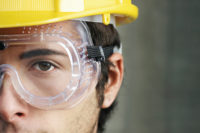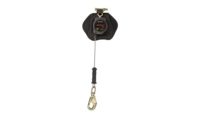Nearly eight years ago, in its Z359.14 Safety Requirements for Self-Retracting Devices standard, ANSI divided self-retracting lifelines (SRLs) into two classes, Class A and Class B. Although it’s been close to a decade, based on many of the technical questions we receive from the field, there is still some misunderstanding as to what these classes mean and how they apply to the real-world situations workers at height find themselves in every day.
The dynamics of distance and force
There are two primary, measurable components that define an SRL’s performance during the arrest of a fall: the distance within which the SRL arrests the fall, and the forces generated during the arrest.
Arrest distance (also referred to as “deceleration distance”) is measured from the point at which the SRL begins to apply force against the fall (but not any free-fall that may occur before this) to the point at which the fall has been fully arrested.
Forces generated are broken into two components: average arrest force and maximum arrest force. Average arrest force is the average of every force reading taken at 1/1000 sec intervals over 500 lbs. during the arrest, and the maximum arrest force is the peak arrest force measured during the arrest.
Both the arrest distance and force measurements are derived from an ANSI-specified test in which a 282 lb. weight is dropped to simulate a 6-foot free fall condition. How arrest distance and arrest force are balanced by an SRL defines its class.
Per ANSI Z359.14-2014, for a worker with a weight capacity between 130-310 lbs, a Class A SRL must arrest a fall within 24 inches and keep average arrest forces to 1,350 lbs. or below, with a maximum arrest force of no greater than 1,800 lbs.
Class B SRLs must arrest a fall within 54 inches and keep average arrest forces to 900 lbs. or below, with a maximum arrest force of no greater than 1,800 lbs. The 1,800 lbs. maximum force requirement should be familiar since it is found in the OSHA 1926.500 Subpart M Fall Protection standard, which states that personal fall arrest systems must “limit maximum arresting force on an employee to 1,800 pounds (8 kN) when used with a body harness.” No matter which class SRL you use, you are OSHA compliant.
Unavoidable trade-off
As the numbers tell, there is a trade-off between arrest distance and arrest forces, with arrest distance being inversely proportional to average arrest force. This trade-off is unavoidable and is part of the balancing act an SRL must perform as it arrests a fall. The shorter distance you have to arrest the fall, the higher the average force (as experienced by the worker) you will generate over that distance. The longer distance you have to arrest the fall, the lower you can keep average arrest forces.
An everyday example is trying to stop a car moving at 55 MPH in 100 feet versus 225 feet. The extra distance allows a more gradual dispersion of the energy generated during braking, as opposed to the sharp spike of energy you feel when you slam on the brakes. For an SRL, the extra 30 inches of room to arrest a fall helps knock off 450 lbs. of average arrest force.
For practical application in the field, the most important point of comparison between a Class A and Class B SRL is arrest distance, since it has a direct effect on total fall clearance. Combined with a standard 18 inches of harness stretch and a 24 inch safety margin, a Class A SRL will require 5 ½ feet of fall clearance and a Class B SRL 8 feet. That 2½ feet might not sound like much, but considering fall protection is required when workers are 6 feet or higher from the next lower level or ground, it starts to make sense. That’s of course not to infer in any way that a Class B SRL is inferior to a Class A; only that different problems will require different solutions, and that when fall clearance is limited, a Class A SRL fits the bill.
Conversely, when fall clearance is abundant and the worker might need an extra-large working radius under the anchor, the Class B works nicely as they are typically available with longer lifelines.
The outlier of leading edge
Given the most import differentiator between Class A and Class B SRLs is arrest distance, and by extension fall clearance, it is logical to include leading edge SRLs (SRL-LE) in the conversation since fall clearance in leading edge conditions can be a challenge. In addition, it is common to find an SRL marked as both a Class B and an SRL-LE device, with anchor point location (overhead/foot level) and potential for lifeline/edge contact the hinges on which the SRL changes its type. SRL-LEs are not required to maintain the same 24 inch or 54 inch arrest distances of Class A and Class B devices; instead, the manufacturer must measure the actual arrest distance based on lab tests and provide this information in the product instructions.
Unlike a Class A or Class B designation, whose technical specifications are the same across manufacturers, an SRL-LE designation is individual to the specific SRL manufacturer and model, meaning safety professionals must take an extra step to re-calculate fall clearance with the supplied fall arrest data when putting an SRL-LE into service.



